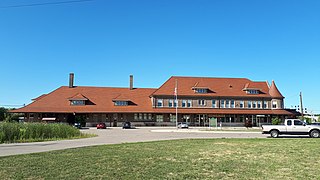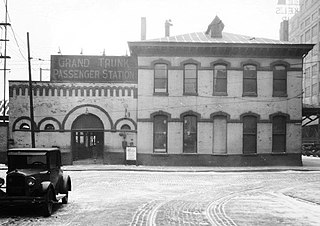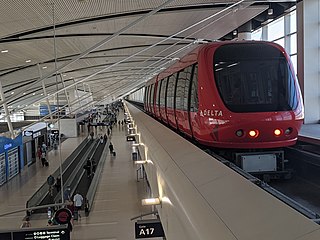
Durand is a city in Shiawassee County in the U.S. state of Michigan. The population was 3,446 at the 2010 census. Nicknamed "Railroad City, USA", it is best known for its large train station which was a major hub for the Grand Trunk Western and Ann Arbor railroads during most of the 20th century, and is currently served by Amtrak. Additionally, several freight carriers use a rail yard in the city, which is accessible from all directions.
The Pere Marquette Railway operated in the Great Lakes region of the United States and southern parts of Ontario in Canada. It had trackage in the states of Michigan, Ohio, Indiana and the Canadian province of Ontario. Its primary connections included Buffalo; Toledo; and Chicago. The company was named after Père Jacques Marquette S.J. (1637–1675), a French Jesuit missionary who founded Michigan's first European settlement, Sault Ste Marie.

The Grand Trunk Western Railroad Company was an American subsidiary of the Canadian National Railway operating in Michigan, Illinois, Indiana, and Ohio. Since a corporate restructuring in 1971, the railroad has been under CN's subsidiary holding company, the Grand Trunk Corporation. Grand Trunk Western's routes are part of CN's Michigan Division. Its primary mainline between Chicago and Port Huron, Michigan serves as a connection between railroad interchanges in Chicago and rail lines in eastern Canada and the Northeastern United States. The railroad's extensive trackage in Detroit and across southern Michigan has made it an essential link for the automotive industry as a hauler of parts and automobiles from manufacturing plants.

The Ann Arbor Railroad was an American railroad that operated between Toledo, Ohio, and Elberta and Frankfort, Michigan with train ferry operations across Lake Michigan. In 1967 it reported 572 million net ton-miles of revenue freight, including 107 million in "lake transfer service"; that total does not include the 39-mile subsidiary Manistique and Lake Superior Railroad.

Michigan Services are three Amtrak passenger rail routes connecting Chicago, Illinois with the Michigan cities of Grand Rapids, Port Huron, and Detroit, and stations en route. The group is a component of the Midwest Regional Rail Initiative.

The Michigan Central Railroad was originally incorporated in 1846 to establish rail service between Detroit, Michigan, and St. Joseph, Michigan. The railroad later operated in the states of Michigan, Indiana, and Illinois in the United States and the province of Ontario in Canada. After about 1867 the railroad was controlled by the New York Central Railroad, which later became part of Penn Central and then Conrail. After the 1998 Conrail breakup, Norfolk Southern Railway now owns much of the former Michigan Central trackage.

Brush Street Station was a passenger train station on the eastside of downtown Detroit, Michigan, located at the foot of Brush Street at its intersection with Atwater Street and bordered by the Detroit River to the south.

The International was a named passenger train operated between Chicago and Toronto. It was originally an overnight train operated by the Grand Trunk Railway of Canada and its successors the Canadian National Railway and Grand Trunk Western Railroad, running as far as Montreal. The train was cut back to Port Huron, Michigan, in 1970 and discontinued in 1971.

The Blue Water is a higher-speed passenger train service operated by Amtrak as part of its Michigan Services. The 319-mile (513 km) route runs from Chicago, Illinois, to Port Huron in Michigan's Blue Water Area, for which the train is named. Major stops are in Kalamazoo, Battle Creek, East Lansing, and Flint.

Battle Creek Transportation Center is an intermodal station in Battle Creek, Michigan, used by Amtrak, Indian Trails and Greyhound Lines. It is at the split between the routes of Amtrak's Blue Water and Wolverine passenger trains. The International Limited, which had started in 1982 as joint operation by Via Rail and Amtrak between Chicago and Toronto, was discontinued in 2004.

Birmingham was an Amtrak train station in Birmingham, Michigan, served by the Wolverine service. The station was located on an embankment at the eastern end of Villa Road, and consisted of a concrete platform with a small shelter and wheelchair lift. On October 13, 2014, the station was closed and replaced by the Troy Transit Center, located about 1,200 feet (370 m) southeast on Doyle Drive in Troy, Michigan.

Jackson station is a historic Amtrak station in Jackson, Michigan, United States. It is served by three daily Wolverine trains between Chicago and Pontiac and a single daily Amtrak Thruway bus between Toledo, Detroit, Jackson, and East Lansing. The station was added to the National Register of Historic Places in 2002.
The Steam Railroading Institute is located at 405 South Washington Street, Owosso, Michigan. It was founded in 1969 as the Michigan State University (MSU) Railroad Club. It became the Michigan State Trust for Railway Preservation, and later adopted its present name.
Spier, Rohns & Gehrke was a noted Detroit, Michigan architectural firm operated by Frederick H. Spier and William C. Rohns, best remembered for designs of churches and railroad stations. These were frequently executed in the Richardson Romanesque style. F.H. Spier, W.C. Rohns and Hans Gehrke were authors of the Detroit Chamber of Commerce, tallest building in the city at the time of construction (1895). Hans Gehrke's well known structures include the Fire Department Headquarters on Larned Street in Detroit, and residence of Robert C. Traub in Arden Park residential district of Detroit.

Transportation in metropolitan Detroit is provided by a system of transit services, airports, and an advanced network of freeways which interconnect the city of Detroit and the Detroit region. The Michigan Department of Transportation (MDOT) administers the region's network of major roads and freeways. The region offers mass transit with bus services provided jointly by the Detroit Department of Transportation (DDOT) and the Suburban Mobility Authority for Regional Transportation (SMART) through a cooperative service and fare agreement administered by the Regional Transit Authority (RTA). Cross border service between the downtown areas of Windsor and Detroit is provided by Transit Windsor via the Tunnel Bus. A monorail system, known as the People Mover, operates daily through a 2.94 mile (4.7 km) loop in the downtown area. A proposed SEMCOG Commuter Rail could link New Center, Dearborn, Detroit Metropolitan Airport, and Ann Arbor with access to DDOT and SMART buses. Amtrak's current passenger facility is north of downtown in the New Center area. Amtrak provides service to Detroit, operating its Wolverine service between Chicago, Illinois, and Pontiac. Greyhound Lines operates a station on Howard Street near Michigan Avenue. The city's dock and public terminal receives cruise ships on International Riverfront near the Renaissance Center which complements tourism in metropolitan Detroit.

The Pontiac Transportation Center is an intermodal terminal station located in Pontiac, Michigan that is served by Amtrak's Michigan Services Wolverine. The transportation center is also served by Indian Trails intercity bus service and Suburban Mobility Authority for Regional Transportation (SMART) regional bus service.

SEMTA Commuter Rail, also known as the Silver Streak, was a commuter train operated by the Southeastern Michigan Transportation Authority (SEMTA) and the Grand Trunk Western Railroad between Detroit and Pontiac, Michigan. It began in 1974 when SEMTA assumed control of the Grand Trunk's existing commuter trains over the route. SEMTA discontinued operations in 1983. Amtrak began offering intercity service between Detroit and Pontiac in 1994 as part of its Michigan Services.

The Maple Leaf was a passenger train pool operated by the Canadian National and the Grand Trunk Western Railroad between Chicago, Illinois and Toronto, Ontario. It operated from 1927 to 1971. The train took its name from the maple leaf, the national symbol of Canada. The Maple Leaf was one of many trains discontinued when Amtrak began operations in 1971, and is unrelated to the Maple Leaf which Amtrak now operates between Toronto and New York City. The train operated on Canadian National railroad territory through Ontario, but west of Lake Huron it operated via Grand Trunk Railroad.

Grand Trunk Western No. 6323 is a preserved class "U-3-b" 4-8-4 "Northern" type steam locomotive built by Alco in 1942. It served the Grand Trunk Western Railroad by pulling various heavy freight and passenger trains across the Lower Peninsula of Michigan and Northern Indiana. It became famous in later years for being the very last active steam locomotive to run on the GTW's trackage while still on the railroad's active list in 1961. After sitting in storage for several years in Detroit, No. 6323 was sold in 1981 to the Illinois Railway Museum, and since then, it has remained on static display in Union, Illinois.


















